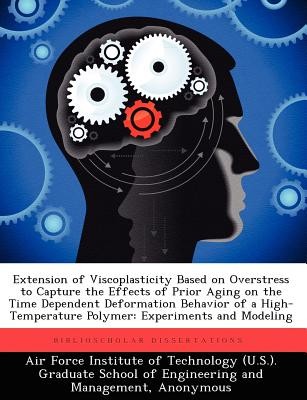
- We will send in 10–14 business days.
- Publisher: BiblioScholar
- ISBN-10: 1249414814
- ISBN-13: 9781249414810
- Format: 18.9 x 24.6 x 1.2 cm, softcover
- Language: English
- SAVE -10% with code: EXTRA
Extension of Viscoplasticity Based on Overstress to Capture the Effects of Prior Aging on the Time Dependent Deformation Behavior of a High-Temperature Polymer (e-book) (used book) | bookbook.eu
Reviews
Description
The inelastic deformation behavior of PMR-15 neat resin, a high-temperature thermoset polymer, was investigated at 288 degrees C. The experimental program was designed to explore the influence of strain rate on tensile loading, unloading, and strain recovery behaviors. In addition, the effect of the prior strain rate on the relaxation response of the material, as well as on the creep behavior following strain controlled loading were examined. The experimental data were modeled with the Viscoplasticity Based on Overstress (VBO) theory. A systematic procedure for determining model parameters was developed and the model was employed to predict the response of the material under various test histories. Additionally the effects of prior aging at 288 degrees C in argon on the time (rate)-dependent behavior of the PMR-15 polymer were evaluated in a series of strain and load controlled experiments. Based on experimental results, the VBO theory was extended to capture the environmentally induced changes in the material response. Several of the VBO material parameters were expanded as functions of prior aging time. The resulting model was used to predict the high-temperature behavior of the PMR-15 polymer subjected to prior aging of various durations.
EXTRA 10 % discount with code: EXTRA
The promotion ends in 16d.21:59:00
The discount code is valid when purchasing from 10 €. Discounts do not stack.
- Publisher: BiblioScholar
- ISBN-10: 1249414814
- ISBN-13: 9781249414810
- Format: 18.9 x 24.6 x 1.2 cm, softcover
- Language: English English
The inelastic deformation behavior of PMR-15 neat resin, a high-temperature thermoset polymer, was investigated at 288 degrees C. The experimental program was designed to explore the influence of strain rate on tensile loading, unloading, and strain recovery behaviors. In addition, the effect of the prior strain rate on the relaxation response of the material, as well as on the creep behavior following strain controlled loading were examined. The experimental data were modeled with the Viscoplasticity Based on Overstress (VBO) theory. A systematic procedure for determining model parameters was developed and the model was employed to predict the response of the material under various test histories. Additionally the effects of prior aging at 288 degrees C in argon on the time (rate)-dependent behavior of the PMR-15 polymer were evaluated in a series of strain and load controlled experiments. Based on experimental results, the VBO theory was extended to capture the environmentally induced changes in the material response. Several of the VBO material parameters were expanded as functions of prior aging time. The resulting model was used to predict the high-temperature behavior of the PMR-15 polymer subjected to prior aging of various durations.


Reviews